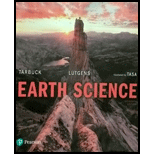
a)
The continental slope, continental rise and continental shelf and shelf break among the given points in the diagram.
a)
Answer to Problem 1GST
Therefore,
- Point-B: Continental shelf
- Point-D: Continental shelf break
- Point-A: Continental slope
- Point-C: Continental rise.
Explanation of Solution
The major features accompanying these margins are as follows:
Continental shelf: It is the gentle sloped submerged surface which extends from the shoreline to the deep ocean basin. It is composed of continental crust. The average inclination of the shelf is about one-tenth of a degree. Its width greatly varies from ocean to ocean.
Continental slope: The seaward edge of the continental edge is known as continental slope. It the boundary between the continental crust and oceanic crust and is relatively steep with an average of 5 degrees.
Continental rise: The extension of continental slope with the thick accumulation of sediment down the slope is known as continental rise. The deep sea fans produced by the canyons merge together to form a continuous wedge shape at the base of the slope. This is termed as continental rise.
b)
The comparison of the size of continental shelf of surrounding Florida to the surrounding size of Florida peninsula.
b)
Answer to Problem 1GST
The size of continental shelf of surrounding Florida is larger when compared to the surrounding size of Florida peninsula.
Explanation of Solution
Continental shelf is the gentle sloped submerged surface which extends from the shoreline to the deep ocean basin. It is composed of continental crust. The average inclination of the shelf is about one-tenth of a degree. Its width greatly varies from ocean to ocean.
From the accompanying map, it can be observed that the size of the Florida is much smaller when compared with the size of the continental shelf surrounding it. The presence of the major part of Florida much below the sea level also proves the same.
c)
The reason for the absence of deep-ocean trenches on the given map.
c)
Answer to Problem 1GST
The given map has no convergent boundaries present and hence there are no deep-ocean trenches.
Explanation of Solution
Deep-ocean trenches are the long, narrow deep trenches located at the deepest parts of the ocean.
These are the prominent features of the convergent plate boundaries. These are formed when he slabs of oceanic slab subducts under the other plate boundary, and plunge into the mantle. It results in the volcanic activity due to the energy released by the scrap of the plate.
Want to see more full solutions like this?
Chapter 13 Solutions
Earth Science (15th Edition)
- N (120') -1180- (120') (105') 0 50 100 feet 1160- -1140- A (100') B (90') (80) Proposed well -1120. (95) (80°) (80') 1100 Well location (Depth to top of water table) A Figure 8.14 Hypothetical topographic map showing the locations of several water wells. The numbers in parentheses indicate the depth of the water table below the surface in each well.arrow_forwardDue tomorrow 3/27 2 pm if you could give me detailed solutions pleasearrow_forwardDue 3/27 at 2pmarrow_forward
- Based on the Climate-Change Censorship campaign article (WSJ) does the phenomenon of scientific certainty ever exist? Why or why not?arrow_forwardBased on the Climate-Change Censorship campaign article (WSJ) some think that twitter, snapchat, instagram, facebook, google, messenger, et al. are the new forums for public discourse. Should the big tech company owners of these sites be allowed to censor the information and comments posted by the public?arrow_forwardHow does radon enter a home?arrow_forward
 Applications and Investigations in Earth Science ...Earth ScienceISBN:9780134746241Author:Edward J. Tarbuck, Frederick K. Lutgens, Dennis G. TasaPublisher:PEARSON
Applications and Investigations in Earth Science ...Earth ScienceISBN:9780134746241Author:Edward J. Tarbuck, Frederick K. Lutgens, Dennis G. TasaPublisher:PEARSON Exercises for Weather & Climate (9th Edition)Earth ScienceISBN:9780134041360Author:Greg CarbonePublisher:PEARSON
Exercises for Weather & Climate (9th Edition)Earth ScienceISBN:9780134041360Author:Greg CarbonePublisher:PEARSON Environmental ScienceEarth ScienceISBN:9781260153125Author:William P Cunningham Prof., Mary Ann Cunningham ProfessorPublisher:McGraw-Hill Education
Environmental ScienceEarth ScienceISBN:9781260153125Author:William P Cunningham Prof., Mary Ann Cunningham ProfessorPublisher:McGraw-Hill Education Earth Science (15th Edition)Earth ScienceISBN:9780134543536Author:Edward J. Tarbuck, Frederick K. Lutgens, Dennis G. TasaPublisher:PEARSON
Earth Science (15th Edition)Earth ScienceISBN:9780134543536Author:Edward J. Tarbuck, Frederick K. Lutgens, Dennis G. TasaPublisher:PEARSON Environmental Science (MindTap Course List)Earth ScienceISBN:9781337569613Author:G. Tyler Miller, Scott SpoolmanPublisher:Cengage Learning
Environmental Science (MindTap Course List)Earth ScienceISBN:9781337569613Author:G. Tyler Miller, Scott SpoolmanPublisher:Cengage Learning Physical GeologyEarth ScienceISBN:9781259916823Author:Plummer, Charles C., CARLSON, Diane H., Hammersley, LisaPublisher:Mcgraw-hill Education,
Physical GeologyEarth ScienceISBN:9781259916823Author:Plummer, Charles C., CARLSON, Diane H., Hammersley, LisaPublisher:Mcgraw-hill Education,





